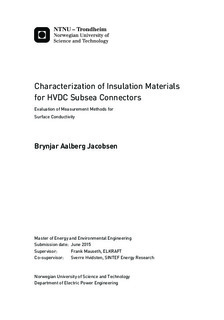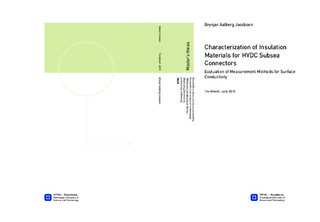| dc.description.abstract | The focus of this work has been on characterization methods for the surface conductivity of insulation materials in HVDC subsea connectors. Having a proper characterization is important when selecting the most suited design and material combinations. Two methods has been investigated; the first is a standard method (ASTM D257), using a test objects geometrical properties, while the second method measures the polarization- and depolarization current (PDC) when it is subjected to a DC step voltage. Due to its widespread use and desirable material properties, the insulation material polyetheretherketone (PEEK) has been used throughout this work. From the PDC method, the surface conductivity is in the range of
4.4·10-15 to 5.7·10-14 S/m for 60 to 80 °C and 500 to1500 V. Fitting the measurements to an empirical equation resulted in the following expression for the surface conductivity in PEEK:
surface_condutivity(T,E) = 9.1x10^(-18)exp(0.1079xT+0.1628xE) [S/m]
Estimations at room temperature and low electric fields resulted in surface conductivities of approximately 10-14 and 10-16 S/m for the standard- and PDC method, respectively. The total deviation between the methods is more than two decades, and combined with the varying degree of uncertainty corresponding to the geometric properties and measured values, it is difficult to determine which method is better. The greatest sensitivity is however achieved with the PDC method, and by improving upon the uncertainties pointed out in this work, this method it is believed to be superior.
From curve fitting of the polarization currents, a two-termed exponential function was found to be a better fit than a single-termed, supporting ionic hopping as the dominating conduction mechanism in PEEK. The measurement time is however too short to determine any deviations between the single- or two-termed function and the resistive current. Thus, assessing whether or not the empirical equation is valid for the surface conductivity in PEEK has not been possible.
When exposed to insulation oil (MIDEL 7131), the surface conductivity of PEEK decreased significantly. The exposure to MIDEL also caused the evaporated electrodes to vanish at 80 °C, which is 10 °C lower than for unexposed PEEK. Depending on the process causing this phenomenon, accelerated ageing of the insulation material could be a possible consequence. Thus, further investigation of this matter and other findings in this work is important for characterizing PEEK for use in HVDC subsea connectors. | |

